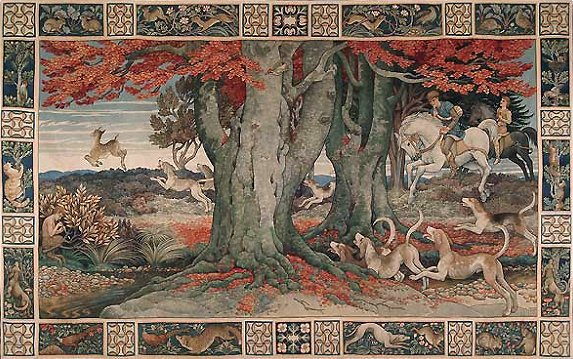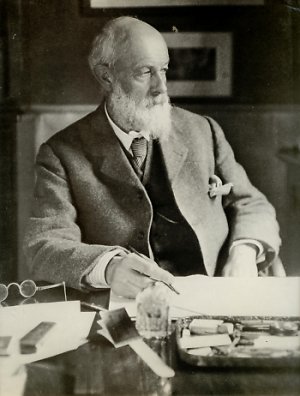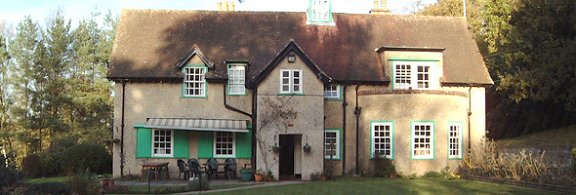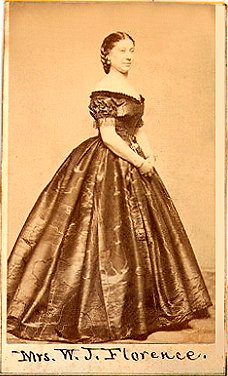

In 1888 the artist Heywood Sumner published a small collection of nine folksongs, under the title The Besom-Maker and other Country Folk Songs. Sumner was a well-known artist and illustrator associated with the late Pre-Raphaelite style and was also an important figure in the Arts and Crafts Movement.  His work as an artist is perhaps best exemplified by his beautiful tapestry The Chase, shown above, which dates to 1888. Sumner's name crops up in all manner of art books, but there is little printed about his interest in folksong. This article is an attempt to rectify the situation.
His work as an artist is perhaps best exemplified by his beautiful tapestry The Chase, shown above, which dates to 1888. Sumner's name crops up in all manner of art books, but there is little printed about his interest in folksong. This article is an attempt to rectify the situation.
George Heywood Maunoir Sumner, usually called Heywood Sumner, was born in 1853 in Old Alresford, Hampshire, and was one of three children. He was to live in Hampshire for most of his life.
Heywood Sumner and his wife had five children, three boys and two girls. In 1897 the Sumner Family moved from London to Bournemouth. Five years later, in 1902, Sumner bought a plot of land at Cuckoo Hill, near Fordingbridge, on the east side of the Avon Valley in Hampshire, where he designed and built a large family house. He became well-known locally for his interest in the archaeology, geology and folklore of the New Forest and Cranborne Chase. Heywood Sumner remained at Cuckoo Hill until his death, aged 87, in 1940. The house remains standing and is, today, used as a care home.

Sometime around the time that Sumner became a barrister, in the early 1880s, he changed direction and became a full-time artist. His earliest publications, two books - The Itchen Valley from Tichbourne to Southampton (1881) and The Avon from Naseby to Tewkesbury (1882) - were illustrated with his own drawings. In 1883 he was asked to illustrate an edition of J E Wise's book The New Forest, so it would seem that Sumner's heart was already set in Hampshire, even though he was then still living in London. In the 1890s Sumner broke away from 'the elitism of the William Morris clique' and helped set up the Fitzroy Picture Society, 'a group of artists dedicated to producing boldly coloured prints that could be sold cheaply to liven up the walls of public institutions such as schools and hospitals'. He also began decorating the Victorian homes of friends and relations and received commissions to provide artistic features for eleven Churches and Chapels, the best preserved being at St Mary the Virgin in Llanfair Kilgeddin, Monmouthshire (1887-88) and at All Saints Church, Ennismore Gardens, London (1897-1903). As well as doing all this, Sumner also found time to paint, design wallpaper, tapestries and other textiles, and produce metalwork and stained glass.
Once established at Cuckoo Hill, Sumner seems to have spent much of his time studying the archaeology of the surrounding area. He excavated several sites and published his findings in several archaeological journals.
The Besom Maker (Roud 910)
As this song was printed on broadsides by both Pitts and Batchelar of London, it may just date to the end of the 18th century. Other 19th century broadside versions appear on sheets by Catnach, Disley and Hodges, all of London, Whiting and Jackson, both of Birmingham, Bennett of Brighton and Pierce of Southborough. The Catnach text is reprinted in Holloway & Black's Later English Broadside Ballads, volume 2, pp.46-47.
The song was widely collected in southern England and versions can be found in the collections of Sabine Baring Gould (Cornwall), George Gardiner (Hampshire), Henry Hammond (Dorset), Cecil Sharp (Somerset) and Ralph Vaughan Williams (Wiltshire).
God Speed the Plough (Roud 1475)
A song that was known to the poet John Clare, see George Deacon's John Clare and the Folk Tradition (1983. pp.233-34). However it has only been collected on a couple of other occasions, once by Cecil Sharp in Somerset and once by George Gardiner in Hampshire).
The Wassail Song (Roud 209)
 This is a quite standard version of a well-known song. It is the only song in the collection to carry a note. At the end of the text Sumner writes, 'In western Somersetshire the chorus, as below, of the Wassail song used to be sung in apple archards on Epiphany Eve. The observance of the custom was supposed to bring good luck to the next year's apple crop'.
This is a quite standard version of a well-known song. It is the only song in the collection to carry a note. At the end of the text Sumner writes, 'In western Somersetshire the chorus, as below, of the Wassail song used to be sung in apple archards on Epiphany Eve. The observance of the custom was supposed to bring good luck to the next year's apple crop'.
My Johnny Was a Shoemaker (Roud 1388)
This song was printed on American song-sheets sometime around 1859. The composer is shown as a Mrs W J Florence, who also sang the song 'Throughout the various Theatres in America and Europe'. The sheets also say that Florence was also the composer of at least two other songs, The Captain and His Whiskers and Bobbing Around. (The Captain and His Whiskers may be found under Roud 2739 and Bobbing Around under Roud 1389).
Mrs Florence was actually Malvina Pray Little (1834 - 1906) and has been described as an 'actress/manager/dancer and singer'. We know that on 25th April, 1881, her husband, Mr W J Florence, an actor, attended London's Theatre Royal, in Drury Lane, at the first night of a revival of J Sheridan Knowles's tragedy Virginius. Oscar Wilde was also in the audience that night as was, possibly, Mrs Florence.
The Reaphook and the Sickle (Round 1375)
This is something of a rarity. Henry Hammond, who found it in Dorset, appears to have been the only other collector to have found a version. Lucy Broadwood reprinted Sumner's set in her book English County Songs (1893. p.148). She also attached the words to another song, The Good Old Leathern Bottle, that can be found on pp.66-67 of the same book.
Hobblety Robbelty How Now (Roud 117, Child 277)
A vesion of the widespread ballad known variously as The Wife Wrapt in Wether's Skin, Robin a Thrush, Dan Doo and The Wee Cooper of Fife.
The Two Young Men of Kenilworth (Roud 764)
Steve Roud links this to the children's song Old Abram Brown (see the Opie's Oxford Dictionary of Nursery Rhymes 1951. p.52). The song has turned up repeatedly in America, as Old (Father) Grimes, or, on at least one occasion, as Mulberry Hill. In England early sets were recorded by George Gardiner (Hampshire) and Cecil Sharp (Somerset and Yorkshire). Other Yorkshire sets have been found by Steve Garnham and Mary & Nigel Hudleston and the Norforlk singer Walter Pardon had a single verse, which he titled Parson Brown.
Forty Dukes a-Riding (Roud 730)
An extremely well-known children's song. Versions have turned up throughout England, Scotland, Canada and North America.
The Jolly Ploughboy (Roud 202).
Best known, as The Two Bretheren, from the version sung by the well-known Copper Family of Sussex (Topic TSCD 534), this song appears to have been highly popular in Susex at the turn of the 20th century. Versions were collected there by Ralph Vaughan Williams, Percy Merrick, Cecil Sharp (who also found it being sung in Somerset), George Butterworth, Anne Gilchrist, and Clive Carey. Henry Hammond turned up quite a few sets in Dorset, while George Gardiner heard the song in Hampshire. Gwilym Davies collected a set in Devon and Percy Grainger found versions in Lincolnshire. The text appeared in a Scottish chapbook, printed by Johnson of Falkirk in 1809), under the title The Farmer's Glory.
As mentioned above, Heywood Sumner was aware of a Somerset version of the Wassail Song, a fact which suggests that he may have looked outside Hampshire for at least some of his songs. It seems, though, that we may never know exactly where most of his songs came from. The song manuscripts do not appear to have survived and, as I said above, Sumner did not say where his singers lived. In the end, though, does it really matter? Some collectors presented their collections under regional titles (Songs from Somerset etc) at a time when they probably knew that such songs were also to be found in different parts of the country. What does matter is the fact that Heywood Sumner took it upon himself to collect a handful of songs which he later presented to the public in a unique manner. His book, The Besom Maker, was printed five years before Lucy Broadwood published English County Songs, and fourteen years before Cecil Sharp heard his first folksong. Sumner was a pioneer collector, an amateur in the best sense of the word, who did what he did because he loved the countryside and the people who lived around him. Folksong collecting may only have played a small part in Heywood Sumner's life, but I, for one, am grateful that it did.
Mike Yates
Wiltshire. March, 2011
2. E David Gregory Pioneers, Friends, Rivals: Social Networks and the English Folksong Revival, 1889 - 1904, a paper delivered at the European Folk Revival conference held at the University of Sheffield, UK, September 6th - 8th, 2007.
3. It seems surprising that Lucy Broadwood included the American song My Johnny Was a Shoemaker in her collection of English songs. However, this was not the only American song to be included. Broadwood also included a version of the American song I'll Tell You of a Fellow (Roud 442) as a 'Leicestershire folk song'. In fact, the song was composed in America pre-1860. There are at least three possible composers. For American recordings, see: Sam McGee - Complete Recorded Works 1926-34 (Document DOCD-8036) and The Hill Billies/Al Hopkins and His Buckle Busters - Volume 1, 1925-26 (Document DOCD-8039). Interestingly, Gavin Greig also collected two versions of the song in Scotland (The Greig/Duncan Folk Song Collection. Volume 4, Aberdeen, 1990, Song # 891).
4. E David Gregory. As above.
Article MT263
| Top | Home Page | MT Records | Articles | Reviews | News | Editorial | Map |